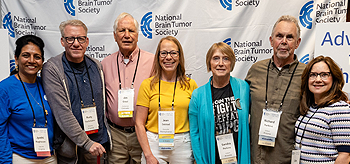Every year, an estimated 91,000 Americans ages 15 and older are diagnosed with a brain tumor. Each diagnosis can turn life upside down. For those who are employed, it adds another layer of complexity, especially since health insurance is often tied to work in the United States.
In the initial whirlwind after a diagnosis, you’ll need to notify your employer, submit paperwork, and plan for time away.
For many people, work is not just a paycheck but also a source of identity, purpose, and connection. Some patients are eager to get back as quickly as possible, while others find the idea daunting.
Every patient’s experience is unique, but there are strategies that can help make the transition smoother. Below, patients with brain tumors share their experiences and tips for returning to work after a brain tumor diagnosis.
1. Understand your medical leave options
As soon as you or a loved one is able, learn what workplace protections and benefits are available to you for short-term or long-term leave.
Employer Paid Leave
Review your employee handbook to verify whether you have short-term and long-term disability leave benefits. If short-term or long-term disability is offered, contact your human resources team to determine the necessary paperwork required to initiate the process.
“I took short-term disability,” said Tim P., who has meningioma. “Recovery from surgery was a strange thing, because there were days when I was ready to start working and doing normal things, but you’re trying to balance out with the reality of needing rest and understanding. Even though I work a regular corporate desk job, using that brain power for 6-8 hours a day would probably have been too much if I’d gone back too soon. I was thankful to have the time.”
Some companies even offer leave for caregivers.
“My company gives eight weeks of carer’s leave per person in your family, so I took off time just to take care of him,” said Melissa M., whose husband has grade 4 anaplastic astrocytoma.
Family Medical Leave Act (FMLA)
The Family and Medical Leave Act (FMLA) provides eligible employees with unpaid leave, job protection, and maintenance of group health insurance benefits in the event of a serious health condition. It also provides protection to people who need to care for a spouse, parent, or child with a serious health condition.
“The one thing I can say is if someone is working and they’re eligible for the Family and Medical Leave Act, take advantage of it,” said Amanda B., who has meningioma. “It’s job protection. As much as you don’t want to think that you would get fired for having a medical condition, it happens.”
People with brain tumors and members of their family may qualify for FMLA depending on their employer and proper medical certification from a health care provider. FMLA eligibility, however, can be more limited than many people expect. To qualify, an employee must:
- Have worked for their employer for at least 12 months
- Have worked at least 1,250 hours in the past year
- Work for a covered employer (all public agencies and private sector employers with 50+ employees within 75 miles)
If the employer is covered by the FMLA and the employee’s FMLA leave is approved, the employee can take FMLA leave for a total of 12 work weeks within a 12-month period. FMLA leave can be taken all at once or on an intermittent basis. Keep in mind that FMLA leave is unpaid, which can come as a surprise.
“At first, I used my vacation days [for appointments] and that made me feel bad,” said Brett S., who has astrocytoma. “Now, each year, I file for FMLA leave and use that for appointments. It slightly lowers my income because the appointment time is unpaid, but the extra time off is worth it.”
Covered service members and their caregivers may be eligible for up to 26 work weeks of FMLA leave in a 12-month period through military caregiver leave.
Employers may request fitness-for-duty certification when the employee is ready to return to work.
State Medical Leave
Thirteen states, along with Washington, D.C., offer paid family and medical leave programs. Ten other states offer voluntary programs that employers can opt into by purchasing through private insurers. Look up your state at NCSL.org to see if a program exists in your area.
Social Security Disability Insurance
Social Security Disability Insurance (SSDI) provides monthly payments to individuals with disabilities that prevent or limit their ability to work. Once a person stops working, they must wait five months before they are eligible to begin receiving their paid benefits. Due to this waiting period, patients are encouraged to start the application process shortly after receiving a formal diagnosis.
If a person qualifies and starts receiving SSDI benefits, they can undergo a trial work period of up to nine months and still receive full disability benefits.
“They have nine months to try to go back to work within a five-year period,” said Lydia Chevere, public affairs specialist with the Social Security Administration. “Now, it’s important for people to know that the nine months do not have to be consecutive.”
For example, a patient thinks they’re ready to return to work after already receiving paid SSDI benefits. They can try to return to work. If they realize they cannot work after a month or two, they can stop without risk to their SSDI benefits. A year later, after more therapy and time to recuperate, they can try to work again.
2. Delegate or outsource work if self-employed
If you run your own business or work for yourself, stepping away can feel impossible. But building in rest is critical. Consider what can be delayed, delegated, or outsourced so you have time to recover after surgery or during treatment.
Katie’s husband, Mike N., flipped houses for a living, so they had to create a plan quickly after his brain tumor diagnosis. Katie shared, “Mike made a deal [with other flippers and contractors] and said, ‘Hey, while I’m in surgery, can you check up on this house, and I’ll pay you a certain percentage of the profit.’ Give them the incentive and get those deals done so that he can take a break for two to three weeks after surgery.”
If you don’t have time to line things up before surgery, consider sending a quick email or message to your customers explaining that you’re dealing with an emergency and responses will be delayed. Most people will understand.
3. Explore reduced work hours upon your return
Work with your manager and HR team to create a return-to-work plan, which may include reduced working hours when you first start back at work. Patients recovering from brain tumor surgery or radiation often find themselves fatigued and dealing with some cognitive challenges, so it can be helpful to ease back into work whenever possible.
“I did request from my medical team a return-to-work letter restricting me from returning to work full-time immediately,” said Donna M-A., who was diagnosed with astrocytoma. “I had just finished my chemotherapy and 6 weeks of radiation, with another 12 months of chemotherapy to go. My medical team provided me with the return-to-work limitations of 20 hours per week, increasing by 5 hours per week until I was back to 40 hours per week.”
When Mike was getting back into the routine of flipping houses following surgery to resect an oligodendroglioma tumor, he intentionally took on fewer projects to reduce his workload.
“He has now offloaded a lot of work and found the right cadence of what I need to be involved in versus what someone else can do for me,” Katie said. “It really is about getting in touch with our values about what we want our lives to be. He’s actually taken on less, and we live with less.”
4. Request additional accommodations
Returning to work after a brain tumor diagnosis can come with unique challenges, from fatigue and cognitive changes to physical limitations and language difficulties. Knowing your rights and options can help you advocate for a smoother transition as part of your return-to-work plan.
“I jumped right into work like I had never left,” said Joe M. about returning to work after his first craniotomy for anaplastic astrocytoma. “I was immediately overwhelmed, and it took its toll on me. I then had to back down a little bit and take things a little slower.”
Americans with Disabilities Act
The Americans with Disabilities Act (ADA) is a federal law that prohibits discrimination against individuals with disabilities in everyday activities, including the workplace. Under the ADA, employers with 15+ employees must provide ‘reasonable accommodations’ to help you perform your essential job duties, unless it causes undue hardship.
Commonly Requested Accommodations
Accommodations vary depending on individual needs, but here are some examples of reasonable accommodations for people living with a brain tumor:
- Fatigue accommodations: Flexible or reduced hours, phased return-to-work, rest breaks, remote or hybrid work, or adjusted shift schedules
- Cognitive accommodations: Written instructions, checklists, task breakdowns, reduced multitasking, quiet workspace, organizational tools, or noise-canceling headphones to reduce background noise
- Language or communication accommodations: Extra time to respond, written summaries of meetings, or speech-to-text software
- Physical accommodations: Ergonomic workstation, adaptive equipment, accessible workspace, modified duties, or parking accommodations
“My place of work gave me extra breaks every two hours of work for about 20 minutes each, so I can step outside and get my head together,” shared Michael S., who was diagnosed with craniopharyngioma.
“I did ask for bigger monitors for my computer, especially when my vision changed four times last year,” Amanda said. “Adjusting the font size helped me a lot. My job allowed me to work from home on days when I felt like I was having a particularly bad day.”
5. Adjust your working style
Before your diagnosis, you may have been able to hyperfocus and knock out tasks quickly, or perhaps you were able to multitask without difficulty. Cognitive changes and fatigue resulting from the tumor or treatment may necessitate adjustments to your work approach.
“When I returned as a remote worker, I struggled more to multitask and wanted all communications to be clearer,” Brett S. said. “I didn’t rely on my memory. I wrote down more things that I could reference — rules, names, etc. I got more monitors so I could see everything at once instead of flipping back and forth. I tried to come up with shortcuts and tricks to save energy.”
As an occupational therapist, Julia C. used to write a bunch of notes all at once. After her diagnosis, Julia would write a couple of notes at a time and take more breaks.
“My executive functioning is somewhat more challenging,” said litigator Jill*, who was diagnosed with astrocytoma. “I needed to learn to use and rely on external reminder systems and processes to a greater extent than before. I need the structure and external support that working in the office provides.”
6. Decide what you’re willing to share
As you head back into the office, consider what you’re open to sharing with your colleagues about your medical leave.
“I kept my brain tumor diagnosis very private because I was concerned that clients would lose confidence in me as a corporate litigator, and that I would not be able to return to the same performance level as before my diagnosis,” Jill* said. “But then, when I was back, that created some awkward moments when I mentioned that I was a brain cancer survivor, and people at work were completely unaware that I had been through that. In retrospect, I feel like I could have been more open, and having the support of colleagues would have been helpful.”
Give yourself permission to set boundaries and share only what you’re comfortable with.
“I shared what was going on, including potential seizures, with people that I trusted at work,” Julia said. “I didn’t share updates with all of my colleagues or people whom I didn’t know well. I also didn’t share details about my mental health struggles, including PTSD.”
Talking about what you’re going through with trusted colleagues also gives you an opportunity to ask for informal support at work.
“When I went back to work, I learned it’s so important to ‘save your spoons’ for the meat of what you need to do and streamline everything else as much as possible,” said Ana H., who has central neurocytoma. “I save my energy — even from small talk and socializing — for the core of what I need to do. I needed to do a computer update, which would use up a lot of my spoons, so I asked my colleague to figure it out for me.”
7. Give yourself grace
Perhaps the most consistent advice survivors share is to be kind to yourself. Recovery is unpredictable, and comparing yourself to others — or to your pre-diagnosis self — can make the return harder.
“The journey doesn’t end when surgery is over and your head is healed or when radiation is over and your hair has grown back,” said Chaka C., who was diagnosed with meningioma. “So many people have gone through a traumatic experience, physically and emotionally. I didn’t realize how much I’d been through until it was ‘over,’ and I was just left processing it. Even if your body has healed, emotionally, you may not have been completely healed.”
Acknowledging progress, however small, can help you move forward.
“I still have fatigue every day,” Chaka said. “I try not to say I’m tired all the time because I feel like a broken record in front of my kids. I frequently remind myself of a saying I came up with, ‘Give yourself a little grace, as we are all living this life for the very first time.’”
8. Prioritize rest
When Michael K. first returned to work after his astrocytoma diagnosis, he took afternoon naps.
He shared, “I told my managers, ‘Hey, I can do the work, but if you’re trying to reach me between two o’clock and four o’clock in the afternoon, I might not respond right away because I might be on the couch napping.’ That was a useful way to get back into it.”
For others, it might be a periodic 15-20 minute break to rest their brain.
“As directed by my cognitive therapist, I returned by working in short spurts: 60 minutes on, 15 minutes nap,” Brett said. “This kept me fresh, and bit by bit, I extended how long I could work in one shot.”
For those who can make it through the workday, ensure you’re getting enough sleep overnight.
“As soon as my workday ends, oftentimes I can be found taking a nap or in bed for the night,” Donna said.
9. Schedule appointments to minimize out-of-office time
Medical appointments are a reality after a brain tumor diagnosis, from follow-up scans to rehab or counseling sessions. While it’s important to prioritize your health first, many survivors find that being strategic about scheduling can help minimize time away from work.
“I preferred to schedule as many medical appointments as close to the end of the business day in the time zone I reside in, which assisted me in not losing ‘working hours’ as a result of the time zone differences,” Donna said. “However, when my oncologist’s office calls, I accept whatever time slot I am given based on his limited availability and client case load. Every week, I work more than my required hours and then adjust my business working hours around the missed hours.”
Others find that simple timing adjustments help reduce disruption.
“Usually, I can schedule the scans early in the morning, and they don’t take very long, so I won’t end up having to miss very much of my workday to go and do it,” Julia said.
10. Consider changing jobs or roles if needed
In some cases, symptoms or side effects can make it challenging to keep a job, stay in the same role, or maintain steady employment after a diagnosis.
Nakeisha C., who was diagnosed with meningioma, said, “I couldn’t go back to my job as an educator, and I actually had to change careers so that I could be in a safer work environment.”
Joelin L. changed jobs when her original employer started nitpicking things she was doing. She found a new position working as a nurse at a clinic.
“It’s not as mentally and physically taxing [as my last job],” Joelin said. “It’s more about being able to talk to the patients one on one, and it’s a totally different environment.”
The Employer Assistance and Resource Network on Disability provides resources for job seekers with disabilities.
11. Find support
Transitioning back to work or learning that you have to take a break from work, however long, can be a lot to process after a brain tumor diagnosis. There are resources available to support you.
Meet with a counselor. “I went into counseling and was diagnosed with PTSD,” Jill* said. “Counseling for the PTSD and recognizing that as a cancer survivor, I was effectively ‘grieving’ the loss of my pre-diagnosis life/self-image, was very helpful.”
Attend a support group. National Brain Tumor Society’s Brain Tumor Support Conversations is a virtual support group that meets monthly. This group is attended by patients and care partners who have had firsthand experience with the challenges and effects of a brain tumor diagnosis.
Use your employee assistance program (EAP). This program is a benefit that many employers offer to support their employees’ well-being. It’s usually free to employees and confidential, meaning your employer won’t know if or why you use it. Refer to your employee handbook or company intranet to determine if your company offers this benefit.
Your company’s EAP may provide:
- Counseling and mental health support (often a set number of free sessions)
- Work-life resources, like help finding childcare, eldercare, or legal/financial advice
- Crisis support during stressful life events
- Referrals to longer-term professional help if needed
Support resources can ease the transition, but recovery is not always a linear process. For some, it means taking extended time away from work and focusing on healing before deciding what’s next.
“I’m planning to take two years to focus on my healing, but it’s hard because I’ve always worked,” said Stephanie L., who worked in nursing management when she was diagnosed with meningioma. “Unfortunately, in our society, we tie that to identity, so that is hard for me. Right now, I’m just trying to really focus on healing, devise new strategies, engage in therapy, and adapt to live with happiness and joy.”
* Note: NBTS altered this name to protect the privacy of the quoted individual.










